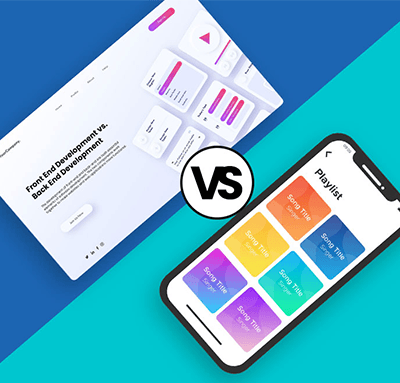
About us
Our Services
Our Expertise
Our Experience
Follow us
Why e2logy?
- We strive to provide superior customer service and ensure that every client is completely satisfied with our work.
- Our engineers are trustworthy, dedicated, and experienced and will go the extra mile to solve your IT issues.
- We are committed to delivering outstanding, cutting-edge IT solutions that add real value that goes beyond what is expected.

Difference between Responsive & Progressive web apps

There are pros and cons to every technology. Businesses should focus on what their clients are looking for. Web apps and RWAs have many similarities. The RWA application operates via a browser and is designed with a web technology stack such as JavaScript, Ruby, HTML, and CSS. The application includes many native-device features, including Progressive Web Apps. As an alternative, progressive web apps can be built with JavaScript, HTML, and CSS.
What Is Progressive Web Application (PWA)?
As opposed to a website, progressive web applications are more like applications. A Progressive Web App looks and feels similar to a native app. An independent PWA download from the Play Store or App Store is not necessary. It runs perfectly in the browser. With PWAs, different problems can be solved, from slow networks to restricted data or no connectivity at all.
A PWA will typically leverage the most up-to-date web technologies to provide a responsive, engaging, and quick user experience. Such social media websites as Gmail and Instagram are prime examples. The websites offer a similar experience to an installed application each time you log in.
How it works
There are a few core components of a PWA that can be summarized easily. To implement all the progressive features above, the following requirements need to be met:
1. Web app manifest
In a web app manifest, the metadata for your PWA is contained. This file is used to facilitate PWA installation and determines how it appears on the home screen of the user.
2. Service workers
Service workers provide progressive features of PWAs independent of the browser and on a different thread to the main JavaScript. They are universally recognized as the building blocks of PWAs.
3. Secure contexts
PWA must be handled through a secure protocol like HTTPS as a new standard for the Web. Having a secure communication channel between a user and a server means that there is no risk to the user.
4. Examples
You might not know that you have visited a PWA website before for the same reason as native mobile applications. Sites like Instagram and Pinterest, which look like applications, are all powered by PWAs.
What Is Responsive Web Application (RWA)?
An adaptive web application is designed to allow users to access it both from desktops and mobile devices. RWA refers to creating different user experiences for different devices comprehensively and holistically. While they have many similarities to PWAs, their only difference is that they don’t support offline usage. It is important to meet the expectations of users if you want to stay in the game for a long time. The answer lies in responsive web application design.
How it works
Responsive web design consists of making design and development responsive to the device used by the user; this means that it reacts to the device’s behavior, size, and platform. CSS media queries and fluid grids allow this to be achieved
1. Fluid Grids
Fluid grid-based responsive websites do a better job of handling the wide range of screen sizes since they do not specify pixels-based dimensions but instead use percentage-based calculations.
2. Flexible images
With some configurations (width and height properties set to auto), any image can be made to be responsive across all devices, even though they are not naturally fluid.
3. CSS Media Queries
The technical responsiveness of a web page with flexible images and fluid grids is good, but the user experience is not. Media queries use CSS to create a better user experience across multiple devices and make the site more responsive. Personalized experiences are often introduced by adding breakpoints at specific screen sizes that take effect.
4. Examples
The use of responsive websites has become a norm, and almost every website you come across has some responsiveness.
Which Is Better For You: Progressive VS Responsive Web Apps?
Every app developer hopes to create functional and impressive apps for their users. The following features were fabricated for it because they are detailed analyses of how responsive vs. progressive apps respond to each of them.
1. Speed
Speed is often a major factor when it comes to Progressive Web Apps (PWA). Even though responsive apps, too, provide great speed, PWAs go one step further. As a result, your mobile app loads faster on all devices, which allows you to improve its effectiveness. PWAs are compatible with old browsers, which is why they are more effective. Furthermore, it provides modern features such as push notifications, offline support, and native audio and video recording capabilities.
2. Work Offline
Offline access to the app is provided by this feature. Meanwhile, responsive apps cannot function without an internet connection, while PWAs can store large amounts of data, allowing offline use. As a result, this has proven beneficial for global brands and helps to reduce buffering time. For example, ZEE 5, an online streaming platform, significantly reduced the app’s buffering time using Performance Web Apps. In addition, users were able to browse through their catalog while offline with Performance Web Apps.
3. Cost Efficiency
All business decisions must also consider cost efficiency. In terms of app development, it is always a good idea to assess whether the investment makes sense. Essentially, a responsive app only needs one line of code, and it can then create the website as required by the screen size on the mobile device. A PWA, on the other hand, must be developed using multiple languages like Javascript, HTML 5, or CSS, each tailored to a particular screen.
The customized version of your website is displayed as soon as a host device’s screen is detected. Due to this, developers will have to develop different versions based on the screen size, which makes PWAs expensive. The software’s other features, such as high speed and native-like experience, also make it quite attractive. They offset the higher cost.
4. User Experience
A successful business today needs to deliver a friendly and impressive user experience. In terms of delivering quality UX, PWAs are the best. The websites look well-developed and rich in content. The PWA is compatible with multiple platforms and provides a native-like experience unlike native apps, which are designed for a specific platform, like iOS or Android.
This is an exceptional value. In addition to being compatible with multiple platforms and featuring features such as SMS/MMS capabilities, task scheduling, file access, offline storage, and location access, it bridges the gap between hybrid and native apps. However, responsive apps lack the native-like experience of native apps, which is a big issue in today’s market, where its UX determines customers’ buying decisions.
5. Accessibility
Users no longer need to continually search for the PWA in their browser, as PWAs can be easily saved on their device’s homepage, ensuring easy accessibility. The user is prompted to launch the full-screen PWA when they click the app icon on their home screen. User interfaces are reloaded at 60fps.
6. SEO and SEM
It is not sufficient to create a website. SEO, SEM, and other marketing tactics are also necessary to get the audience’s attention. SEO and SEM apply to both responsive and progressive apps. Search engines use them to index your website, allowing you to maximize visibility by using keywords. Having an effective website ranking on the first page of a search engine is a result of all the above factors. Paid search engine marketing can also be used to promote a business.
Conclusion
Tons of big companies have already adopted PWAs, including Flipkart, Lyft, Twitter, Starbucks, and others. PWA is becoming the future of responsive web applications, and the possibilities are endless, whereas the responsive web is becoming a thing of the past. Progressive web apps and responsive web apps both have their benefits and drawbacks. You have to decide which technology is best for your requirements based on the pros and cons of both.













